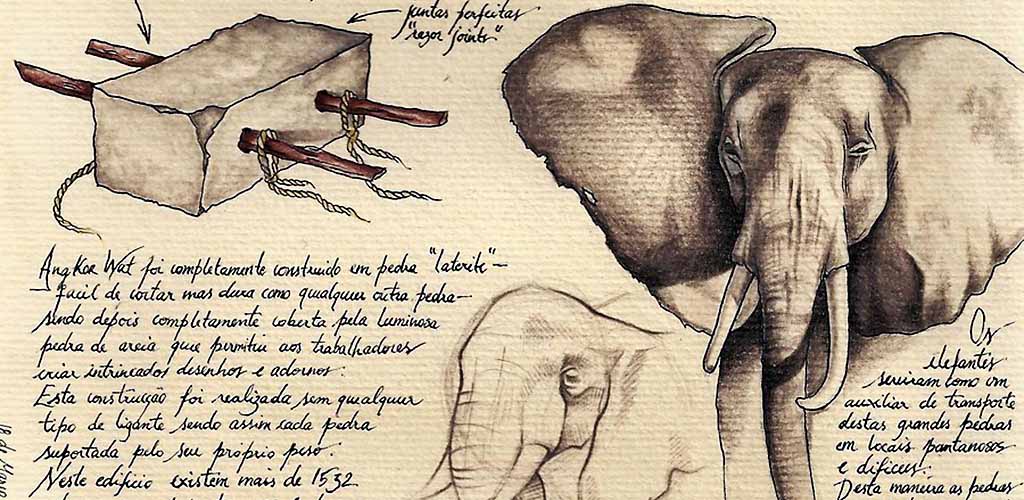Cambodia Travel Books
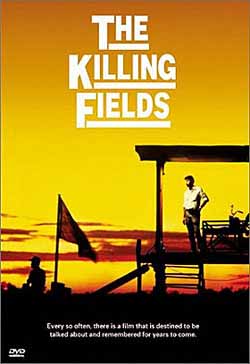
The Killing Fields
An engrossing, horrific story made into an Academy Award winning film. The killing fields is a story about war and horror, murder and terror but also about hope and friendship. The story emerges in the early 1970s in war torn Cambodia, where the communist Khmer Rouge are trying to overthrow the American backed government of Lon Nol. The American journalist Sydney Schaumburg and his Cambodian assistant Dith Pran are covering the advance of the Khmer Rouge towards the capital of Phnom Penh.
In 1975 when the rebels finally enter the capital and seize power, the lives of the residents change dramatically. The Khmer Rouge want to impose a stone age-like agriculture communism and for that purpose they force the whole population to live and work on the countryside and besides they try to kill all educated, upper class and critical people. As the foreigner Schanberg will soon be sent out of Cambodia, for Pran, as a well educated Cambodian citizen things soon turn to the worst. What follows is a three year struggle for life.
In 1986, actor Spalding Gray, who had a small role in the film as the American consul, created Swimming to Cambodia, an acclaimed monologue (later filmed by Jonathan Demme) based upon his often humorous experiences making The Killing Fields.
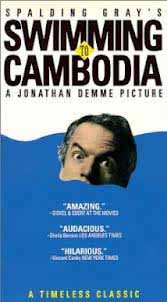
Swimming to Cambodia (DVD)
Regardless of the subject, Cambodia, Spaulding Grey's then novel, now classic, spellbinding 87-minute monologue . Swimming to Cambodia is a 1987 film directed by Jonathan Demme (Silence of the Lambs) in which actor Spalding Gray performs an amusing monologue that mostly recounts his trip to Southeast Asia to create the role of the U.S. Ambassador's aide in the 1984 Oscar-winning film The Killing Fields.
Roger Ebert noted that Grey "is a spellbinding storyteller, and as he speaks, something occurs that might be called the "radio phenomenon." This is the same effect that was created in "My Dinner With Andre" (1981), another movie in which the characters simply sit and talk. Although we are essentially only seeing a face on a screen, we are picturing the story's events in our minds; it's like listening to a radio play. Gray is not afraid to be dramatic. His voice races quickly through a litany of images, his arms wave, his eyes flash. Then sometimes he is quiet, contemplative. "
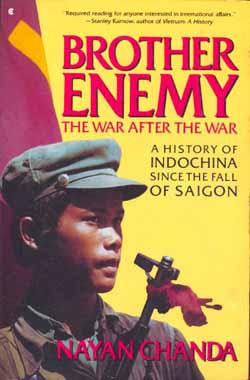
Brother Enemy
Chanda, Washington bureau chief for Far Eastern Economic Review, traces the steps by which the Third Indochina War became intertwined with the Soviet-American rivalry and the Sino-American alliance.
The book reveals in detail how close Washington came in 1977 to establishing ties with Hanoi and why President Carter shelved the issue. Chanda presents a startling and well-supported explanation for the Cambodian massacres: a Khmer Rouge decision that Cambodian revolutionary power had to be built at breakneck speed by means of ideological "purification" to prepare for the inevitable life-or-death struggle against the Vietnamese.
He goes on to show that the Khmer Rouge sought to preempt the invasion by taking the war to Vietnam itself, upsetting not only Hanoi's timetable but that of Peking as well. Chanda notes that Vietnam, once a hero of the Third World, has become an international pariah, largely due to Hanoi's policy toward Cambodia.
Indochina Travel Comments: "A very well researched and written book on Cambodia history - number one if your interests lie in the political intrigue of the period" ~Andy Brouwer
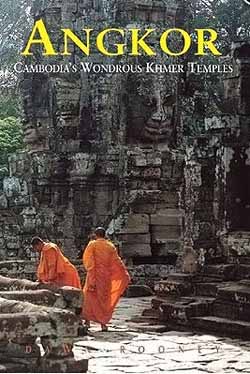
ANGKOR: Introduction to the Temples
The great legacy of the ancient Khmer civilization, the temples of Angkor cover an area well over 200 square kilometers (77 square miles) in northwest Cambodia. These monuments, built between the ninth and 15th centuries—the classic period of Khmer art—are unrivaled in architectural greatness.
They are, undoubtedly, one of the wonders of the world, astounding in their splendor and evoking a real sense of awe. This beautifully illustrated book contains background information on Khmer history, religious beliefs and legends depicted on the bas-reliefs, as well as descriptions of architectural features.
This detailed, monument-by-monument guide to the sites includes detailed maps and plans, plus information about temple complexes accessible by helicopter or four-wheel-drive vehicle. New 6th Edition published in 2011 - this long-awaited sixth edition, with an additional 180 pages of text and more than 80 new color photographs, offers detailed monument-by-monument itineraries and maps to the temple sites. Includes practical information Siem Reap and Phnom Penh.
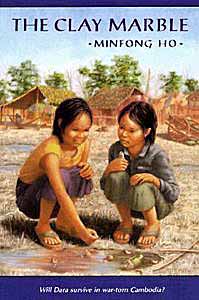
The Clay Marble
After the fall of the Khmer Rouge, 12-year-old Dara, her older brother Sarun, and their mother journey to the Thai border in search of food. Here they meet the remnants of another Cambodian family, one of whose members, Jantu, becomes Dara's friend; another, Nea, falls in love with Sarun. Life is going along well until infighting among neighboring guerrilla groups forces the families to flee again. In the confusion, Dara and Jantu become separated from the main group.
After many incidents, they are reunited with their families, although Jantu is shot in the process and dies soon after. Sarun, once a proud farmer, wants to join the military. Dara courageously stands up to him, and convinces him to return home with the family. The title comes from Jantu's effervescence and manual dexterity, the combination of which impresses Dara as magic. She believes a clay marble, having been invested with Jantu's magic, gives her the courage to get through her ordeals. Dara and Jantu are well drawn, but the rest of the characters are not much more than pasteboard figures.
Ho excels at tropical description, evoking climate and flaura with skill. The contrasts of frantic activity and enervating inaction of refugee life are also vividly depicted. However, Dara's vocabulary when she thinks to herself does not ring true for her age; few 12-year-olds would consciously characterize themselves as "irritable" or others as "glib"--certainly not illiterate 12-year-olds from rural areas. Older children might find this novel of interest for its historical milieu or slice-of-life realism, albeit from a different reality. Grades 5-9. -John Philbrook, San Francisco Public Library [Amazon Link]
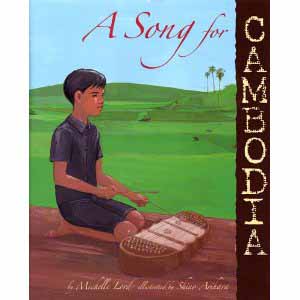
A Song for Cambodia
Prewar Cambodia offered an almost idyllic boyhood to Arn Chorn, but the Khmer Rouge turned his world upside down, separating him from his family and sending Arn to a work camp. He survived the camp by learning to play the khim, a traditional Cambodian instrument. Sent to fight the Vietnamese, Arn fled to the jungle, fell ill, woke up in a refugee camp, nearly drowned in a flood, and was rescued and brought to the U.S. by Reverend Peter Pond, who adopted him.
Through music, Arn slowly adjusted to his new country but promised to return to Cambodia. An after word describes his subsequent efforts to assist war survivors and revive traditional Cambodian arts and music. Filled with drama and tragedy, this picture-book biography skillfully telescopes Arn’s tumultuous boyhood. Realistic gouache illustrations depict the terrors of war but refrain from showing graphic violence. Amazing and inspiring, this biography is an excellent choice for multicultural studies. Grades 3-5. --Linda Perkins [Amazon Link]
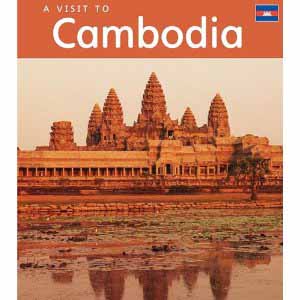
A visit to Cambodia
"How long is monsoon season? How do Cambodians use palm tree leaves? When do Cambodians celebrate New Year? Read this newly revised and updated book and find out! See the famous sites, travel over the land and join in the celebrations.
Find out what school life is like and what the children might do when they are older. See which sports are played in Cambodia and even learn a few words of Khmer."
Ages 6 and up [Amazon Link]
Cambodia Film & Video
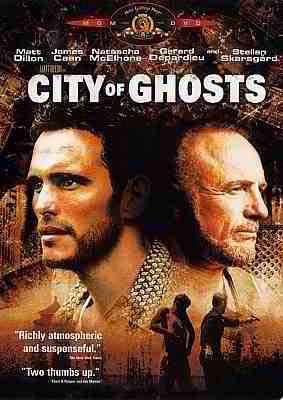
The City of Ghosts
Poorly reviewed, but it's the setting in Cambodia that makes this film worthwhile. Shot on location (no sets here) featuring local Cambodian non-actors such as Dillon's sidekick in the movie, Sok (Kem Sereyvuth), a real life pedicab driver from Phnom Penh. Directed (his first) and and acted by Dillon (full discloser, Mr. Dillon is a client of ours), the film also stars James Caan, Natascha McElhone, and Gérard Depardieu.
Gritty, tense, this film noir captures Cambodia during the lawless period of the 90s when shady foreign characters, Khmer Rouge bandits, and local gangsters ranged freely across the country.
Note: Dillon is a big fan of 1960s Khmer rock and put together the soundtrack. —Patrick Morris
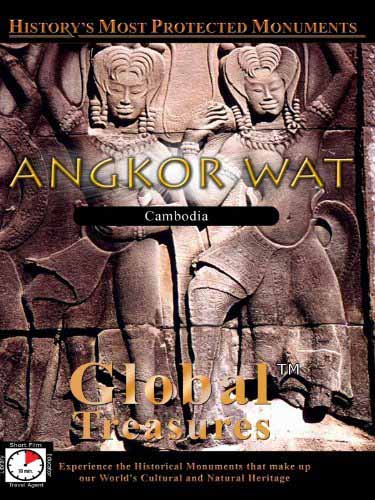
Amazon Instant Video
If you are an Amazon Prime member, there are a surprising number of free streaming videos (nearly 20) available on the company's Instant Video service.
Videos include Global Treasures: Angkor Thom, Global Treasures Angkor Wat, Vista Point Phnom Penh, 7 Days Cambodia, and Nourished by the Same River. [Amazon Link]
Ready to get started planning your own Cambodia trip?
Submit a contact request form, or call us:
San Francisco at or (415) 418-6800 , or in Hanoi at (84-4) 3562-6665
